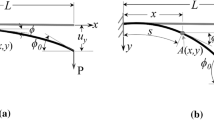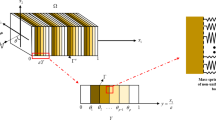Abstract
Existing theoretical values and experimental values of magnetoelastic critical buckling fields for ferromagnetic beams and plates differ by a factor of two. The usual theoretical treatment assumes that the plate (a) is immersed in an infinite uniform field, (b) is infinitely wide and long, and (c) is made of a linearly magnetic material. We present an experimental investigation, combined with a simple analysis, which determines specific criteria which must be satisfied by experimental programs in order to validate the three assumptions. It is shown that experimental arrangements which validate (a) and (c) are feasible, but not (b). Hence, there is need for improved theoretical treatments which take into account the finite size of the specimens.
Similar content being viewed by others
Abbreviations
- B o :
-
strength of (uniform) magnetic field prior to insertion of specimen, same as the field strength in the uniform portion of the field remote from the specimen (gauss)
- B s :
-
strength of the field at the surface of the specimen (gauss)
- B oc :
-
the critical value ofB o at which buckling of the specimen occurs (gauss)
- D e :
-
distance from specimen edge to point where field distortion ends, measured transverse toB o outward from specimen (in. or cm)
- D s :
-
distance from specimen edge to point where field distortion ends, measured transverse toB o inward toward center line of specimen (in. or cm)
- E :
-
modulus of elasticity (lb/in.2 or N/m2)
- f :
-
empirical constant in empirical formula eq (5) (gauss)
- g :
-
gap of magnet (in. or cm)
- l :
-
length of specimen (in. or cm)
- L :
-
length (or width) of pole face (in. or cm)
- L s :
-
length (or width) of specimen corresponding toL (in. or cm)
- r :
-
ratio of width to length of specimen
- t :
-
thickness of specimen (in. or cm)
- x, y, z :
-
coordinates locating a field point
- η(x,z):
-
plate deflection (in. or cm)
- μo :
-
the magnetic permeability of air (dimensionless in Gaussian system)
References
Moon, F. C. andPao, Y. W., “Magnetoelastic Buckling of a Thin Plate,”J. Appl. Mech.,35,Trans. ASME,90,Ser. E,53–58 (1968).
Popelar, C. H., “Postbuckling Analysis of a Magnetoelastic Beam,”J. Appl. Mech.,39 (1),207–211 (1972).
Wallerstein, D. V. andPeach, M. O., “Magnetoelastic Buckling of Beams and Thin Plates of Magnetically Soft Material,”J. Appl. Mech.,39 (2),451–455 (1972).
Popelar, C. H. andBast, C. O., “An Experimental Study of the Magnetoelastic Postbuckling Behavior of a Beam,”Experimental Mechanics,12 (12),537–542 (Dec. 1972).
Dalrymple, J. M., Peach, M. O., andViegelahn, G. L., “Magnetoelastic Buckling of Thin Magnetically Soft Plates in Cylindrical Mode,”J. Appl. Mech.,41,Ser. E, (1),145–150 (1974).
Author information
Authors and Affiliations
Rights and permissions
About this article
Cite this article
Dalrymple, J.M., Peach, M.O. & Viegelahn, G.L. Magnetoelastic buckling: Theory vs. experiment. Experimental Mechanics 16, 26–31 (1976). https://doi.org/10.1007/BF02328918
Issue Date:
DOI: https://doi.org/10.1007/BF02328918




